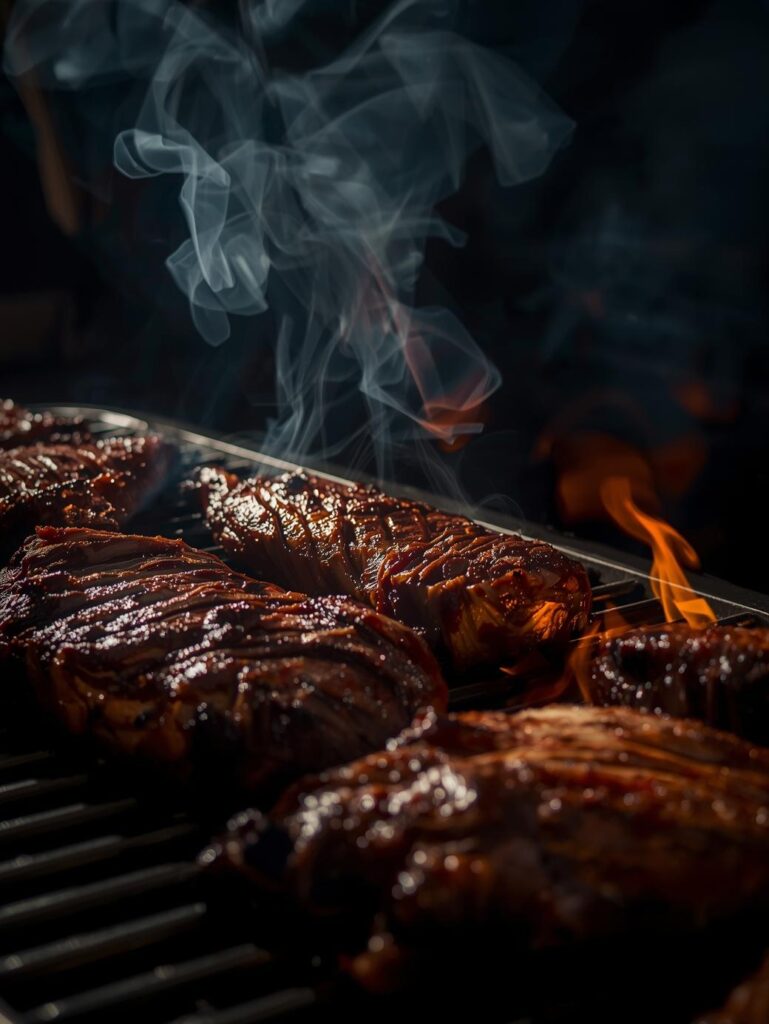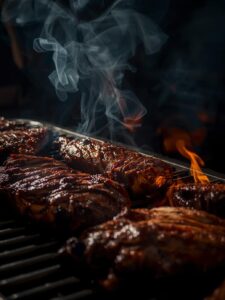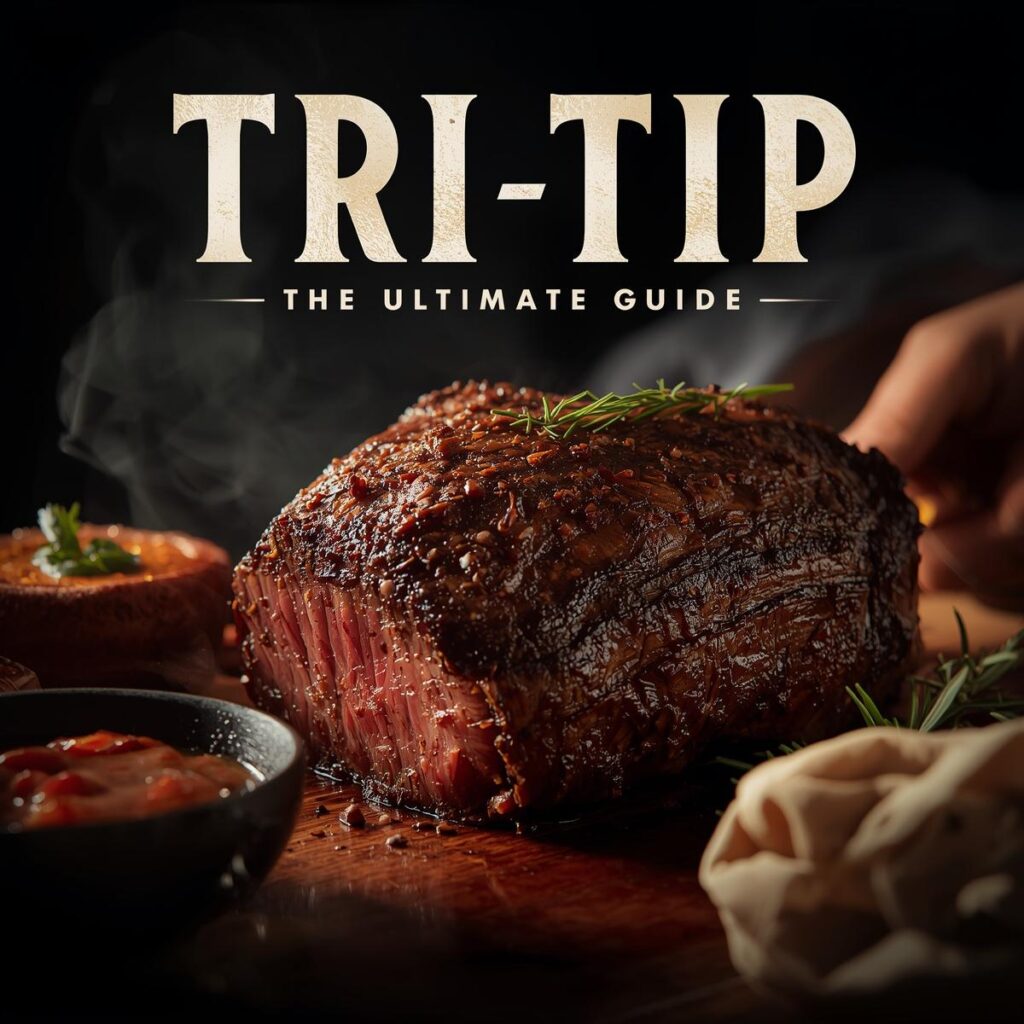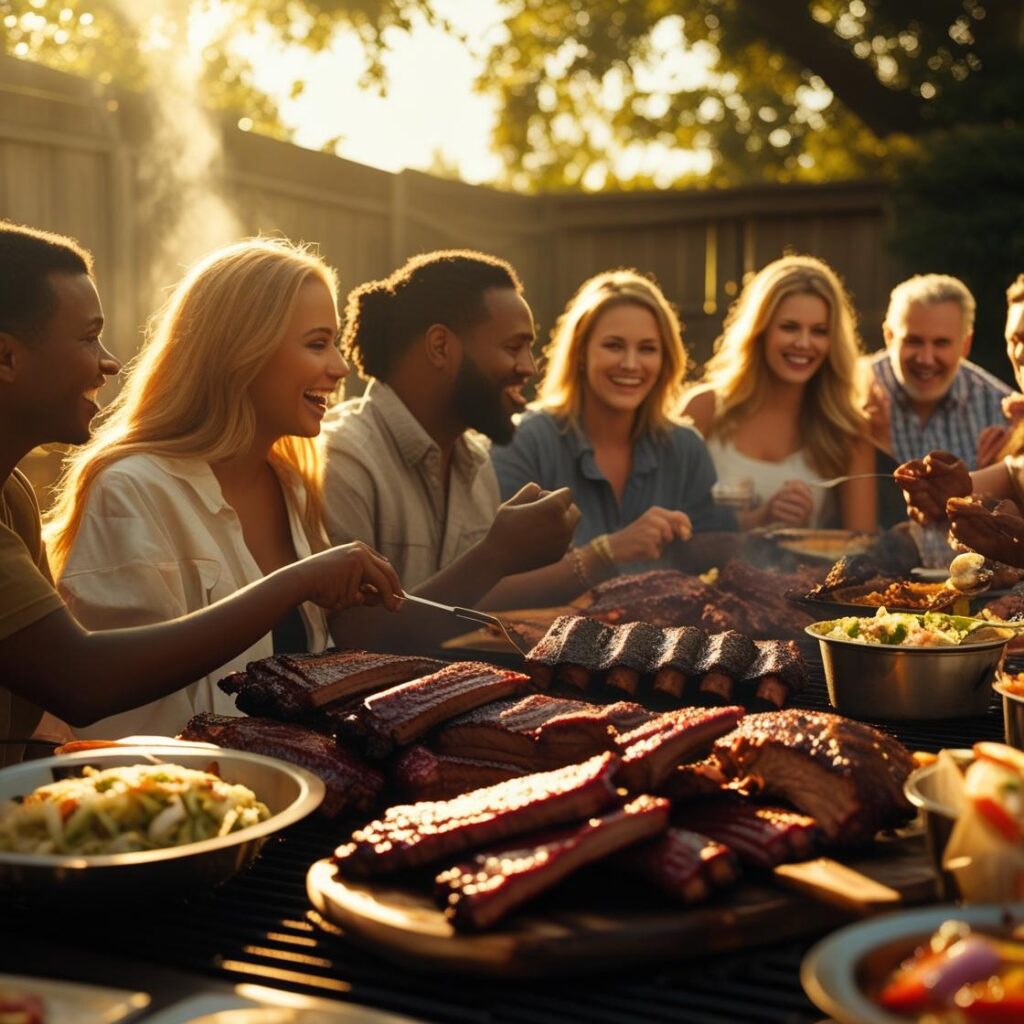California BBQ Expert’s Note: This guide continues our global BBQ series with one of America’s most elegant and underappreciated regional traditions. Santa Maria Style BBQ isn’t just cooking—it’s a 150-year-old celebration of Central California’s agricultural bounty, where tri-tip reigns supreme, red oak provides the perfume, and simplicity becomes the ultimate sophistication. While the South slow-smokes and Texas obsesses over brisket, the Central Coast has been perfecting the art of quick-grilled beef with a flavor so pure it needs no sauce to shine.
Santa Maria Style BBQ: California’s Best Secret
“While American BBQ typically means ‘low and slow,’ Santa Maria Style whispers something different: ‘hot and fast.’ Born from Spanish ranchero traditions and refined by Central Coast ingenuity, this is BBQ that respects the meat’s natural flavor above all else. No heavy sauces, no 16-hour cooks—just quality beef, salt, pepper, garlic, and the subtle smoke of red oak. This isn’t just California’s best-kept secret; it’s the most elegant expression of American barbecue.”
Santa Maria Style BBQ: California’s Best Secret
Download the Santa Maria Rub Recipe & Grilling Timeline
Welcome to the world of Santa Maria Style BBQ—where tri-tip is king, red oak is the wood of choice, and the entire meal comes together in under an hour. This Central California tradition represents a road less traveled in American barbecue: one where the quality of ingredients matters more than complex techniques, where the fire is a partner rather than a tool, and where the phrase “no sauce needed” isn’t a boast but a simple statement of fact. This guide will transport you to the oak-studded hills of Santa Barbara County and show you how to master this deceptively simple, incredibly delicious style.
🎯 THE SANTA MARIA PHILOSOPHY: SIMPLICITY AS ULTIMATE SOPHISTICATION
Understanding Santa Maria Style means embracing restraint and ingredient quality.
⚙️ The Four Pillars of Santa Maria BBQ Culture
Quality, Simplicity, Fire, Community
- The Tri-Tip Revolution: In the 1950s, Santa Maria butchers discovered that the previously overlooked tri-tip cut—when seasoned simply and grilled over red oak—became something magical. This cut’s perfect balance of flavor and tenderness made it the star of the style.
- Spanish Ranchero Roots: The tradition dates back to 19th-century Spanish vaqueros (cowboys) who would grill meat over open pits during large community gatherings. The modern style preserves this communal, celebratory spirit.
- The No-Sauce Philosophy: Santa Maria BBQ is sauceless by design. The belief is that high-quality meat, proper seasoning, and red oak smoke need no embellishment. The optional salsa is served on the side, never on the meat.
- Community Feast Mentality: Traditional Santa Maria BBQ isn’t a solo endeavor—it’s a social event centered around the grill, with friends and family gathering as the meat cooks and the pinquito beans simmer.
🎯 Santa Maria vs. Traditional American BBQ: The Style Divide
🇺🇸 Traditional BBQ
- Low & slow (6-18 hours)
- Complex rubs & sauces
- Pork & brisket focus
- Indirect heat/smoking
- Heavy smoke flavor
🇺🇸 Santa Maria Style
- Hot & fast (30-60 min)
- Salt, pepper, garlic only
- Beef tri-tip focus
- Direct grilling
- Subtle oak smoke
🔪 THE SANTA MARIA LEXICON: SPEAKING THE LANGUAGE
First rule of Santa Maria mastery: learn the terms or risk sounding like a tourist.
🗣️ Essential Santa Maria BBQ Terminology
Master the Vocabulary of Central Coast BBQ
- Tri-Tip (The Star): The triangular cut from the bottom sirloin that defines Santa Maria BBQ. Perfectly marbled, great flavor, and ideal for quick grilling.
- Red Oak (The Wood): The only wood used in traditional Santa Maria BBQ. Provides a subtle, sweet smoke that complements beef without overpowering it.
- Santa Maria Seasoning (The Rub): The holy trinity: coarse salt, black pepper, and garlic powder. Nothing else needed.
- Pinquito Beans (The Side): Small pink beans native to the area, cooked with bacon, onions, and spices. The mandatory side dish.
- Salsa (The Condiment): A fresh, chunky tomato-based salsa served on the side, never on the meat. Typically includes tomatoes, onions, cilantro, and mild chilies.
- French Bread Dusting (The Technique): Grilling sliced French bread on the grill to soak up meat drippings—a traditional starter.
- Vaqueros (The Origin): The Spanish cowboys who started the tradition during large community barbecues.
- Santa Maria Grill (The Equipment): A specific grill design with adjustable height over a red oak fire.
📊 The Santa Maria BBQ Matrix: The Complete Spread
🎯 The Essential Santa Maria BBQ Components
| Component | Traditional Choice | Preparation | Serving Style | Essentiality |
|---|---|---|---|---|
| Main Protein | Tri-Tip Roast | Seasoned S/P/G, grilled over red oak | Sliced against the grain | 🇺🇸 Non-negotiable |
| Beans | Pinquito Beans | Slow-cooked with bacon/sausage | As side dish | 🇺🇸 Mandatory |
| Bread | French Bread | Grilled, buttered, garlic optional | Starter, soaks juices | 🇺🇸 Traditional |
| Salad | Green Salad | Simple greens, minimal dressing | Cool contrast | 🇺🇸 Classic |
| Salsa | Fresh Salsa | Tomato, onion, cilantro, mild heat | On the side only | 🇺🇸 Optional |
| Wood | Red Oak | Local hardwood, subtle smoke | Fuel source only | 🇺🇸 Essential |
🔥 THE SANTA MARIA GRILL SETUP: AUTHENTIC VS ADAPTED
The unique grill design is as important as the ingredients in traditional Santa Maria BBQ.
🎪 Traditional Santa Maria Grill: The Adjustable Height Marvel
Engineering for Perfect Grilling
- Adjustable Grill Grate: The signature feature—a crank or pulley system that raises and lowers the cooking grate over the fire. This allows precise heat control without moving the meat.
- Red Oak Firebox: A wide, shallow steel box that holds a bed of red oak embers. The design ensures even heat distribution across the entire cooking surface.
- No Cover: Traditional Santa Maria grills are open—no lid. This preserves the direct heat cooking method and prevents “oven-like” cooking.
- Steel Construction: Typically made from 1/4″ steel to withstand high heat and years of use. The heavy construction maintains consistent temperatures.
- Size Matters: Traditional grills are 3-4 feet wide to accommodate multiple tri-tips for large gatherings—staying true to the community feast origins.
🎪 Modern Adaptations: Achieving Authentic Results Anywhere
Santa Maria Style on Standard Equipment
- Kettle Grill Method: Use a Weber kettle with a vortex or slow ‘n sear to create a hot direct zone. Grill with lid off for authentic char.
- Gas Grill Adaptation: Use a gas grill on high heat with a smoker box filled with red oak chips or chunks. Keep lid open during cooking.
- Offset Smoker Hack: Cook directly over the firebox of an offset smoker, using red oak as your primary fuel.
- Campfire Style: The most authentic adaptation—grill over a red oak campfire using a simple grill grate on adjustable stands.
- Key Principles: Whatever your equipment, maintain direct heat, use red oak for smoke, and keep the cooking open (no lid).
🥩 THE TRI-TIP MASTERY: CUT, SEASON, GRILL
Tri-tip success comes from understanding this unique cut’s characteristics.
🔪 Tri-Tip Anatomy & Selection
Choosing and Prepping the Star
- Cut Identification: Look for the triangular shape (hence “tri-tip”) from the bottom sirloin. Should be 2-3 pounds with good marbling.
- Grain Understanding: Tri-tip has grains running in two directions. Identify both grain patterns before cooking for proper slicing later.
- Fat Cap: Traditional Santa Maria style leaves a thin fat cap (1/4 inch) for flavor. Trim excess but don’t remove completely.
- Quality Matters: Since there’s no sauce to hide behind, use the best beef you can find. Choice grade or higher recommended.
- Butcher’s Secret: Ask for “untrimmed” or “Santa Maria cut” tri-tip for the most authentic experience.
🧂 Seasoning & Grilling Technique
The Simple Perfection
- The Trinity Rub: Equal parts coarse salt, coarse black pepper, and garlic powder. Be generous—the crust is your flavor.
- No Marinade: Traditional style uses no marinade. The quality beef and seasoning should stand on their own.
- Temperature Target: Grill to 130-135°F internal for medium-rare, the preferred doneness in Santa Maria.
- Reverse Sear Option: While not traditional, some modern cooks sear first then move to cooler part of grill to finish.
- Resting Critical: Rest for 15-20 minutes before slicing. The carryover cooking is significant with this direct heat method.
📋 THE ULTIMATE SANTA MARIA BBQ TIMELINE
The 2-Hour Journey to Santa Maria Perfection
Fire & Prep (60 min before)
Start red oak fire, season tri-tip, prep beans/salsa, set table.
Grilling Phase (25-35 min)
Grill tri-tip to 130°F, grill bread, warm beans, make salad.
Rest & Final Prep (20 min)
Rest meat, finish sides, slice bread, assemble salsa.
Serve & Enjoy (Immediate)
Slice against grain, serve with all components, enjoy immediately.
🚨 SANTA MARIA BBQ TROUBLESHOOTING: COMMON MISTAKES & SOLUTIONS
🎯 Fixing Common Santa Maria Style Problems
| Problem | California Description | Cause | Solution |
|---|---|---|---|
| Tough Meat | “Chewy like boot leather” | Wrong slicing, overcooked, wrong cut | Slice against grain, cook to 130°F, use tri-tip |
| Bland Flavor | “Tastes like nothing” | Insufficient seasoning, low-quality meat | Be generous with S/P/G, buy better beef |
| Burnt Outside | “Burnt to a crisp” | Fire too hot, no height adjustment | Lower heat, raise grill, use two-zone |
| No Smoke Flavor | “Where’s the oak?” | Wrong wood, gas grill, lid closed | Use red oak, smoker box, cook open |
| Dry Beans | “Beans are dust” | Overcooked, insufficient liquid | Soak beans, more broth, lower heat |
🏁 MASTERING CALIFORNIA’S BEST SECRET
Mastering Santa Maria Style BBQ means embracing a different philosophy of American barbecue—one where simplicity reigns supreme, ingredient quality is non-negotiable, and the communal experience matters as much as the food itself. This isn’t just another regional variation; it’s a testament to the idea that sometimes the most sophisticated flavors come from the most straightforward techniques.
Your Santa Maria journey starts with sourcing the right ingredients: a well-marbled tri-tip, authentic red oak, and the confidence to let quality speak for itself. Then comes mastering the direct heat fire that gives this style its characteristic crust and juicy interior. Finally, you’ll discover the joy of serving a complete meal where every component—from the grilled bread to the pinquito beans—plays its part in creating a perfect culinary harmony.
So find that tri-tip, gather your red oak, and remember the three rules of Santa Maria mastery: respect the ingredients, control the fire, and never complicate what nature made perfect. Your journey to becoming a Central Coast BBQ expert starts now.
🇺🇸 START WITH TRI-TIP MASTERY →
Master the star of Santa Maria BBQ with our complete tri-tip selection and grilling guide
Explore More American BBQ Traditions: Continue your journey through America’s diverse BBQ landscape.





